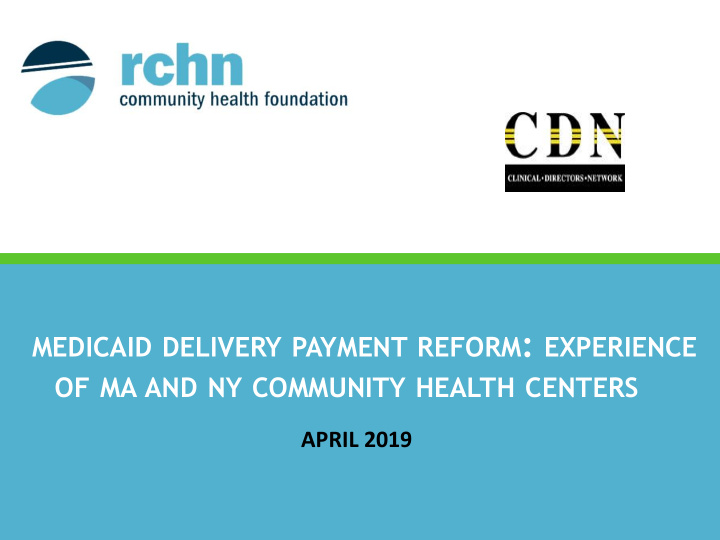



MEDICAID DELIVERY PAYMENT REFORM : EXPERIENCE OF MA AND NY COMMUNITY HEALTH CENTERS APRIL 2019
Welcome and Introduction to the Webcast Program RCHN Community Health Foundation Feygele Jacobs, DrPH President and CEO
Featured Speaker: Milken Institute School of Public Health The George Washington University Sara Rosenbaum, J.D. Harold and Jane Hirsh Professor of Health Law and Policy
Featured Speaker: Viaduct Consulting Vikki Wachino, MPP Principal
Featured Speaker: Community Health Care Association of New York State Rose Duhan, MPH President and CEO
Featured Speaker: Massachusetts League of Community Health Centers Kaitlin McColgan Vice President, Government Affairs & Public Policy
Sara Rosenbaum Vikki Wachino Rebecca Morris
Background • Medicaid Delivery System and Payment Reform (DSRIP) 1115 demonstrations advanced comprehensive state delivery system and payment reform, included federal investments • 10 active state DSRIP demonstrations in 2017 • New York and Massachusetts DSRIPs reflect distinct local health care environments and relationships with community health centers • Community health centers have a major interest in delivery/payment reform given Medicaid’s role in patients (49%) and revenue (44%)
New York (DSRIP 2015-2020) • DSRIP goals – Reduce avoidable hospitalizations – Improve care integration – physical and behavioral – Increase value-based payment to 80%-90% of all managed care payments – Focus on population health • PPS Model (25 local systems) – Emphasis on hospitals as PPS lead organizations – ability to run large systems and drive performance – Attribution based on total use patterns, not just primary care • DSRIP investments flow through the PPS organizations • Hospitals play a role in financing DSRIP state share
Massachusetts (DSRIP 2017-2022) • DSRIP goals – Improve care physical/behavioral care integration – Improve provider accountability for quality and cost – Sustain safety net providers serving both Medicaid and uninsured patients within near-universal coverage system • DSRIP attribution model – Based on regular source of primary care • Created 3 ACO models Accountable Care Partnership Plan: Provider-led ACO partnered with a single MCO Primary Care ACO: Provider-led ACO contracting directly with MassHealth MCO Administered: Provider-led ACO contracting with one or more MCOs. • Hospitals do not play a role in financing DSRIP state share
New York Health Centers • 65 CHCs serve 1 in 9 NY residents • Health center relationships to PPS – Local focus reflects the politics and policy behind the PPS model, as well as distinctions in the NY political and financing environment. – One health center-led PPS – All health centers in at least one PPS – Health center involvement varies in terms of payment design and as part of provider governance structure – DSRIP primary care investment comes through local PPS – Health centers very focused on local care delivery and quality improvement.
Massachusetts Health Centers • 39 CHCs serve 1 in 9 residents • History of state policy focus and direct state policy involvement – Longstanding direct relationship between state health policy leaders and health centers – State – views health centers as an independent asset in transformation • Health centers work at 2 levels – state and local – 1 CHC-led ACO – 1 CHC/hospital/MCO partnership – All health centers as ACO participants – Direct state investments in health centers through DSRIP (practice transformation and workforce)
Key Takeaways • Medicaid agencies and health centers have a shared mission and mutual dependence • Health centers as local leaders • Importance of state policy focus – Delivery/payment reform design that makes sense for health centers – Direct investment in strengthening primary care practice – Attribution formula that emphasizes primary care – Health centers as delivery system leaders
Lessons learned from NYS DSRIP For the State: For CHCANYS: The existing entrenched health FQHCs are high performers care delivery model has been who drove improved quality reinforced over time. outcomes in DSRIP projects. Health care systems that FQHCs value as innovative and prioritize prevention, wellness flexible leaders in developing and chronic disease contracting, payment and care management are a models can shape future revolutionary shift from transformation efforts. established models of health Regional health center care delivery. collaboration can positively To truly transform the system, impact health centers’ role as we must invest differently and drivers of local health care. sustain investments over time .
State investment must support access Community-based to comprehensive primary care: comprehensive 1. Workforce funding specifically primary care is the targeted at primary care training and practice sites, including foundation of a pipeline development redesigned health 2. Comprehensive care models that emphasize and empower care system that management prioritizes prevention 3. Behavioral health and primary care and well being. integration infrastructure 4. Primary-care led contracting entities 5. Capacity-building for primary care providers to prepare for Alternative Payment Methodologies
Mass. League of Community Health Centers Waiver Lessons Engage early with members and state on workforce and capacity needs Transformation is transformative: dedicate time to considering 360 º view of pre- and post-DSRIP realities; game plan out scenarios with knowledgeable advisors Cannot prepare or educate enough; think about who will be at negotiating table for key areas. For PCAs: if not you, then what content/prep do members need to be prepared to advocate within/for their new constructs. ***Good working relationship with the state is paramount to even considering this path.***
Comments/Questions?
Thank you Feygele Jacobs RCHN Community Health Foundation www.rchnfoundation.org 55 Broadway, 15th Floor New York, New York 10006 Phone: (212) 246-1122 ext., 712 Email: fjacobs@rchnfoundation.org
Recommend
More recommend